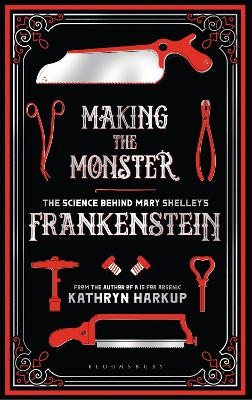
Making the Monster
Bloomsbury Sigma (Verlag)
978-1-4729-3373-7 (ISBN)
- Titel ist leider vergriffen;
keine Neuauflage - Artikel merken
The year 1818 saw the publication of one of the most influential science-fiction stories of all time. Frankenstein: or, The Modern Prometheus by Mary Shelley had a huge impact on the gothic horror and science-fiction genres, and her creation has become part of our everyday culture, from cartoons to Hallowe'en costumes. Even the name ‘Frankenstein’ has become a by-word for evil scientists and dangerous experiments. How did a teenager with no formal education come up with the idea for such an extraordinary novel?
Clues are dotted throughout Georgian science and popular culture. The years before the book's publication saw huge advances in our understanding of the natural sciences, in areas such as electricity and physiology, for example. Sensational science demonstrations caught the imagination of the general public, while the newspapers were full of lurid tales of murderers and resurrectionists.
Making the Monster explores the scientific background behind Mary Shelley's book. Is there any science fact behind the science fiction? And how might a real-life Victor Frankenstein have gone about creating his monster? From tales of volcanic eruptions, artificial life and chemical revolutions, to experimental surgery, 'monsters' and electrical experiments on human cadavers, Kathryn Harkup examines the science and scientists that influenced Shelley, and inspired her most famous creation.
Kathryn Harkup is a chemist and author. Kathryn completed a doctorate on her favourite chemicals, phosphines, and went on to further postdoctoral research before realising that talking, writing and demonstrating science appealed a bit more than hours slaving over a hot fume-hood. She wrote a monthly poison blog for the Guardian and gives regular public talks on the disgusting and dangerous side of science. Kathryn’s first book was the international best-seller A is for Arsenic, which was shortlisted for a Mystery Readers International Macavity Award and a BMA Book Award, and she is also the author of Death by Shakespeare: Snakebites, Stabbings and Broken Hearts and Superspy Science: Science, Death and Tech in the World of James Bond. @RotwangsRobot
Preface
PART 1: CONCEPTION
Chapter 1: Enlightenment
Chapter 2: Development
Chapter 3: Elopement
Chapter 4: Nascent
PART 2: CREATION
Chapter 5: Education
Chapter 6: Inspiration
Chapter 7: Collection
Chapter 8: Preservation
Chapter 9: Construction
Chapter 10: Electrification
Chapter 11: Reanimation
PART 3: BIRTH
Chapter 12: Life
Chapter 13: Death
Epilogue
Appendix: Timeline of Events
Bibliography
Acknowledgements
Index
| Erscheinungsdatum | 05.02.2018 |
|---|---|
| Zusatzinfo | 11 black and white illustrations |
| Verlagsort | London |
| Sprache | englisch |
| Maße | 135 x 216 mm |
| Gewicht | 433 g |
| Themenwelt | Sachbuch/Ratgeber ► Natur / Technik |
| Geisteswissenschaften ► Sprach- / Literaturwissenschaft ► Anglistik / Amerikanistik | |
| Studium ► 1. Studienabschnitt (Vorklinik) ► Anatomie / Neuroanatomie | |
| Naturwissenschaften ► Biologie ► Humanbiologie | |
| ISBN-10 | 1-4729-3373-7 / 1472933737 |
| ISBN-13 | 978-1-4729-3373-7 / 9781472933737 |
| Zustand | Neuware |
| Haben Sie eine Frage zum Produkt? |
aus dem Bereich


